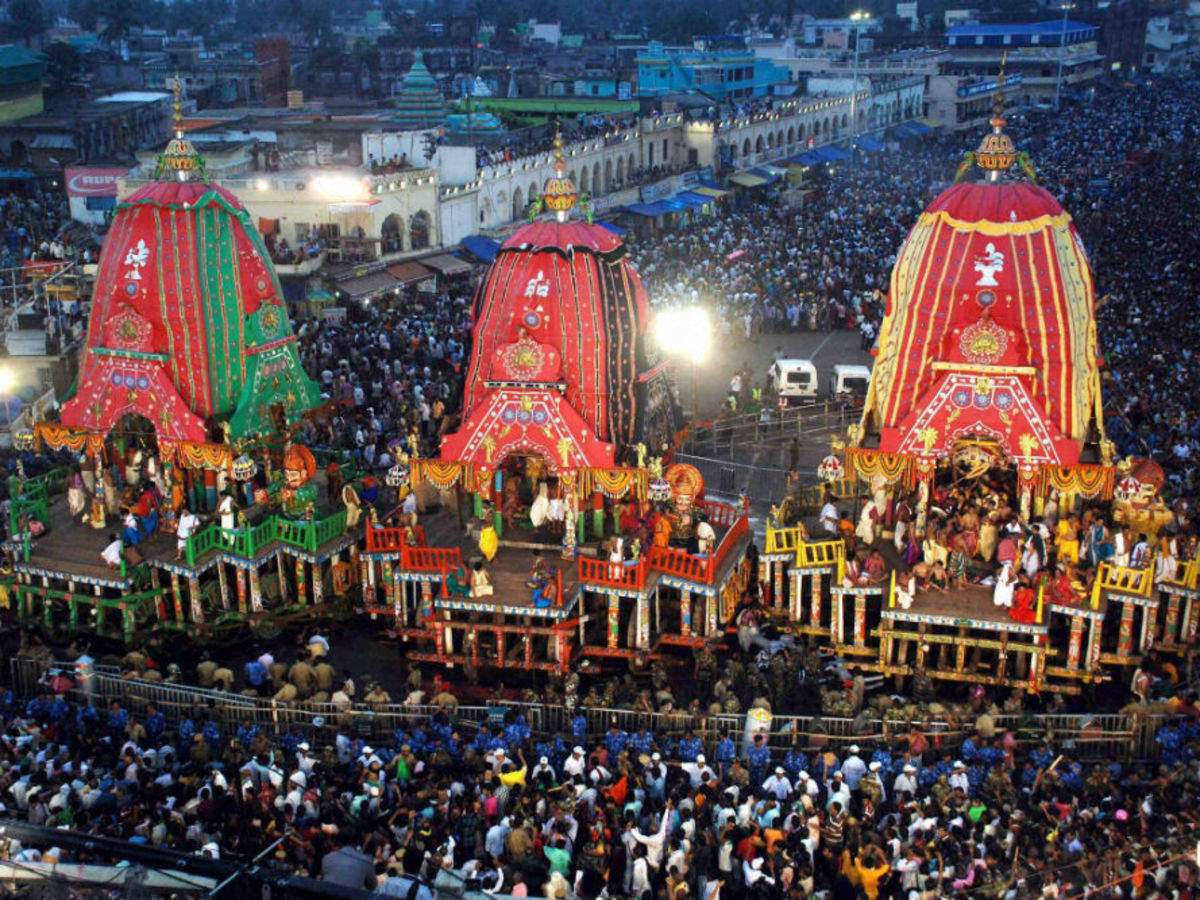


The coastal city of Puri in Odisha is all set to host the annual Rath Yatra festival, which will see hundreds of traditional carpenters and painters bring the three huge chariots of Lord Jagannath, Balabhadra, and Subhadra to Singha Dwara of Puri Srimandir. The security arrangements have also been beefed up with the deployment of 180 platoons of forces and special operations groups to ensure the smooth and safe conduct of the festival. The President of India is also expected to attend the festival.
The Sacred Rath Yatra of Odisha's Puri Temple: A Journey of Devotion and Tradition
The coastal city of Puri in Odisha, India, is renowned for its annual Rath Yatra festival, a grand celebration that attracts millions of devotees from across the globe. This festival commemorates the journey of Lord Jagannath, Lord Balabhadra, and Goddess Subhadra from their abode in the Jagannath Temple to the Gundicha Temple.
Historical Roots
The origins of Rath Yatra can be traced back to ancient scriptures such as the Mahabharata and the Skanda Purana. According to legend, Lord Krishna longed to visit his birthplace, Mathura. Upon learning this, his elder brother, Lord Balarama, built three chariots for Krishna, his wife Rukmini, and his sister Subhadra to undertake the journey.
The Chariot Construction
The construction of the three chariots is a remarkable spectacle in itself. Hundreds of traditional carpenters and painters work tirelessly for months to create the massive wooden structures. Each chariot is elaborately adorned with intricate carvings, vibrant colors, and sacred symbols.
The Grand Procession
The Rath Yatra begins with a grand procession that involves the movement of the three chariots from the Jagannath Temple to the Gundicha Temple. The chariots are pulled along by thousands of devotees who chant hymns and devotional songs. The procession is accompanied by traditional music, dance, and fireworks.
Legend of the Chariot Wheels
As the chariots make their way through the streets of Puri, it is believed that the wheels of Lord Jagannath's chariot sometimes crush the devotees who prostrate before them. This is considered an auspicious sign and is known as "Chhera Panhara" (wheel crushing).
Top 5 FAQs
1. When is Rath Yatra celebrated? Rath Yatra is typically held in June or July, coinciding with the Ashadha month of the Hindu calendar.
2. How long does Rath Yatra last? The festival lasts for nine days. The first day is the procession to the Gundicha Temple, and the ninth day is the return journey to the Jagannath Temple.
3. Who attends Rath Yatra? Millions of devotees from around the world attend Rath Yatra, including the President of India and various dignitaries.
4. What are the security measures in place? Security arrangements are beefed up during Rath Yatra, with the deployment of police and special operations groups to ensure the safety of devotees.
5. What are the past incidents related to Rath Yatra? In 2016, a stampede occurred during Rath Yatra, resulting in the deaths of several devotees. However, such incidents are rare, and the festival is generally celebrated peacefully.

Marking a historic moment, President Droupadi Murmu offered prayers at the Sabarimala Temple in Kerala, becoming the first serving state head to do so. She climbed the 18 sacred steps to reach the shrine and offered darshan to Lord Ayyappa, carrying the sacred bundle on her head. This visit holds symbolic significance as the president represents both Vaishnavism and Shaivism, making it a moment of unity in Hinduism.

As Diwali celebrations come to an end, the day after is marked by the auspicious festival of Govardhan Puja or Annakut. In 2025, this festival falls on Wednesday, 22 October, and is a reminder to express gratitude towards nature and the environment. Devotees prepare special offerings and decorate their homes with flowers and diyas, honoring Lord Krishna and the bounty of nature. While the article provides general guidance, it also urges readers to consult experts before implementing any beliefs or practices discussed.

The Udupi Catholic diocese has extended warm Diwali greetings, citing the festival as a symbol of moving from darkness to light, falsehood to truth, and death to new life. The diocese emphasizes India's diversity and unity in celebrating different festivals together. Sharing a symbolic story, the diocese urges people to be the candle of hope that relights peace, faith, and love in the world. The message concludes with a call to action to be the light that builds bridges of love, faith, and compassion.

The Hindu Vikram Samvat calendar marks October 22, 2025, as Gujarati New Year, a day of renewal, positivity, and joy for devotees. From early morning prayers to temple visits, sweets, and sharing warm messages, the day is a festive symbol of hope and abundance. As it falls a day after Diwali, it's also a time to open new accounts, perform rituals like Chopda Puja, and spread love, gratitude, and togetherness with family and friends.

As Diwali celebrations come to an end, Mumbai is facing a major problem of poor air quality. The city is engulfed in a thick layer of smog, with visibility reduced to minimal in some areas. The situation has been worsened by unseasonal rain, with no significant improvement in air quality. It is not just Mumbai, but several other cities in India are also dealing with pollution levels breaching the "very poor" and "severe" categories. With AQI readings hitting 380 in some areas, measures need to be taken to combat this worsening air quality situation.

Kiran Mazumdar-Shaw, founder of Indian biotech giant Biocon, met with top government officials in Karnataka, including Chief Minister Siddaramaiah, to discuss the city's deteriorating infrastructure. This follows a recent social media post where Shaw called out the government for their ineffective management and lack of accountability. With heavy rains expected in the coming days, these concerns take on even more urgency as residents brace for potential waterlogging and traffic congestion.

Hospitals in the city have reported an increase in burn cases linked to the celebration of Diwali, with over a hundred cases reported at AIIMS Delhi alone. Despite the worsening air pollution, no major increase in respiratory distress cases was seen, but senior doctors anticipate an increase in the coming days. Several patients who suffered burns during the festival recounted how even seemingly harmless firecrackers resulted in severe injuries. While most cases were minor, a total of 129 patients were treated for firecracker-related injuries at Safdarjung Hospital.

Diwali, the festival of lights, is a celebration of good over evil and light over darkness. This festival is rooted in a rich history of mythological connections, with Hindus commemorating Lord Rama and his victory over the demon king Ravana. However, Diwali is not limited to just one faith - it is celebrated across beliefs and traditions, including Jains, Sikhs, and Newar Buddhists. Festivities and celebrations during this time include illuminations, rituals, feasting, and community gatherings, making it a time of joy, renewal, and gratitude.

Maharashtra Chief Minister Devendra Fadnavis honors the brave officers who sacrificed their lives in an ambush laid by Chinese troops in Ladakh. He pays respects at the martyrs' memorial on Police Commemoration Day, highlighting their inspiration for courage and integrity. The event is observed annually to remember the 10 valiant policemen who lost their lives in the line of duty.

Prime Minister Narendra Modi marked Diwali by joining the armed forces aboard INS Vikrant, India’s indigenous aircraft carrier. A cultural programme on the vessel, showcasing the creative talents of naval personnel, left a lasting impression on the PM. He took to Twitter to express his admiration for the emotional and artistic depth within the armed forces, highlighting the symbolic power of Diwali – light triumphing over darkness – as a reflection of India’s growing strength.